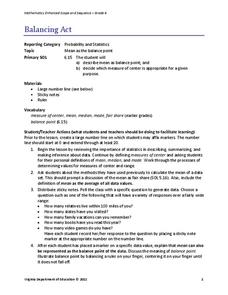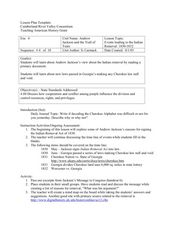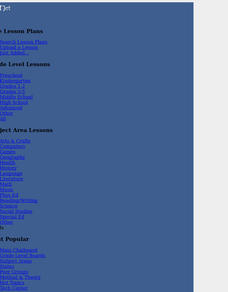Virginia Department of Education
States of Matter
Scientists have been studying exothermic reactions before they were cool. The lesson begins with a discussion and a demonstration of heat curves. Scholars then determine the heat of fusion of ice and the heat needed to...
Virginia Department of Education
Molar Volume of a Gas
What is a chemist's favorite plant? Stoichiome Tree! Scholars produce hydrogen gas by reacting magnesium with hydrochloric acid. Then they calculate the molar volume of the gas produced before answering assessment questions.
Virginia Department of Education
Laboratory Safety and Skills
Avoiding lab safety rules will not give you super powers. The instructional activity opens with a demonstration of not following safety rules. Then, young chemists practice their lab safety while finding the mass of each item in a...
Virginia Department of Education
Historical Models of Atoms
What does the past have to do with today? Young scientists find that answer as they learn more about past chemists and their significant contributions to the field. Pupils use the Internet to research historical figures...
Virginia Department of Education
Logic and Conditional Statements
If there is a conditional statement, then there is a hypothesis and conclusion. Pupils learn how to identify the parts of conditional statements. Class members continue to work with conditional statements and rewrite them in their many...
Virginia Department of Education
Linear Curve of Best Fit
Is foot length to forearm length a linear association? The class collects data of fellow scholars' foot length and the length of their forearms. They plot the data and find a line of best fit. Using that line, they make predictions of...
Advocates for Human Rights
The Right to a Clean Environment in the United States
Even if a school has gone digital, chances are there's still plenty of paper being used. The three activities help scholars learn about the environmental impact of paper and another consumer products of their choosing, the issue of...
Virginia Department of Education
Balancing Act
How many different interpretations of the mean are there? Scholars place numbers on a number line and determine the mean. They interpret the mean as the average value and as the balance point.
Virginia Department of Education
Radioactive Decay and Half-Life
Explain the importance of radioactive half-life as your high school biologists demonstrate the concept by performing a series of steps designed to simulate radioactive decay. Pupils use pennies to perform an experiment and gather data....
PBS
Broadcast News
Just because a story is on the news doesn't mean it's being presented fairly. Analyze news broadcasts with a lesson focused on evaluating television journalism. At home, kids watch a news show and note the stories presented, including...
Theodore Roosevelt Association
Interpreting the Past; Assessing Its Impact on the Present
Even though the presidency of Theodore Roosevelt ended over 100 years ago, we can still learn something from his stances and policies that is applicable today. Class members first look over a list of prevalent political issues from the...
Curated OER
Missing May
Students listen to the first couple chapters in the book, Missing May by Cynthia Rylant and then sketch or write about a character or the setting, using words and phrases from the book as guides. They then discuss the chapters using the...
Curated OER
Events Leading to the Indian Removal 1830-1832
Learners consider the effects of Indian Removal on the Cherokee Nation. In this American history activity, students research Internet and print sources regarding the Indian Removal Act of 1830. Learners write short stories that detail...
Curated OER
Veterans Day
First graders examine the history and significance of Veteran's Day. They discuss each of the military branches and how Veteran's Day was started, and write a thank you letter to a Veteran. Students copy the greeting and closing of the...
Curated OER
Swallowing Stones by Joyce McDonald Unit Plan
Students read Joyce McDonald's, Swallowing Stones while investigating the literary elements used in the writing. They define a large number of vocabulary words to be applied when reading. Finally, they write a persuasive essay.
Curated OER
Where Am I?
Second graders listen to a Japanese folk tale called "The Traveling Frogs". They role play the story using puppets or costumes. They locate Japan on a map and discuss several geography topics. They independently write about ways they...
Curated OER
Weather Journal Log
Students discuss the weather each day and log it on a class chart for a month.
Curated OER
When I Was Puerto Rican
Students are read passages from When I Was Puerto Rican and asked to respond to the passages in their journals. They decide on a topic for researching and they use this topic to develop their own memoirs.
Curated OER
Wrapping up The Stone Cutter
Students write a paper in which they detail the daily routine of an architect. In this The Stone Cutter lesson, students discuss the end of the novel and share journals with peers. Students choose a time period in which to...
Curated OER
The Sun: An Introduction
Pupils write entries in their Science Journals as they explore the Sun.
Curated OER
Re-Viewpoints From 2002
Students explore how editorials use various devices to convey a message to a reader. They select key news topics from 2002 and write their own editorials.
Curated OER
Self-Esteem through Literature and Music
Students research representations of self-esteem in music and literature, reflect on their meanings and use in developing positive attitudes. They make a presentations based on their research. They also keep a daily journal.
Curated OER
Personal / Group Magazine
Sixth graders complete the magazine template in the Macmillan "Writer's Journal" available through the basic skills department using word processing, spreadsheet, graphic, and electronic resource (i.e.-Internet) skills
Curated OER
Sarah, Plain and Tall
Students read Sarah, Plain and Tall, and they write a journal entry for each chapter. They can write about anything that come to mind as you read the story. Students are able to draw in the journal. They write down key words or...























